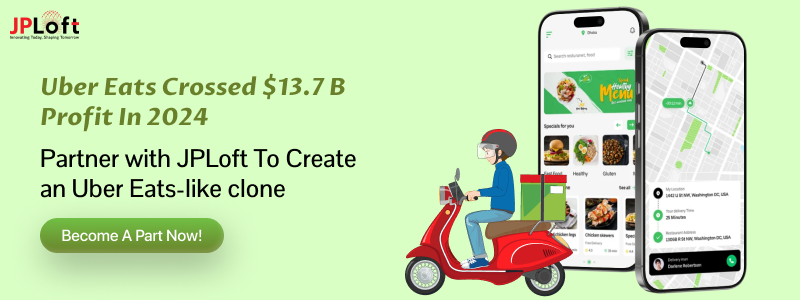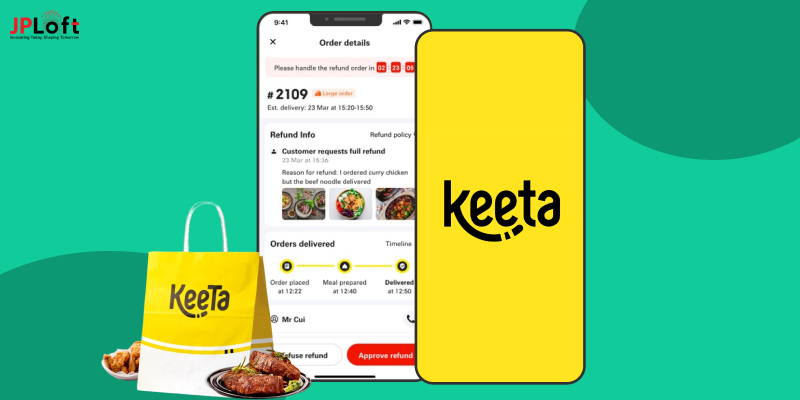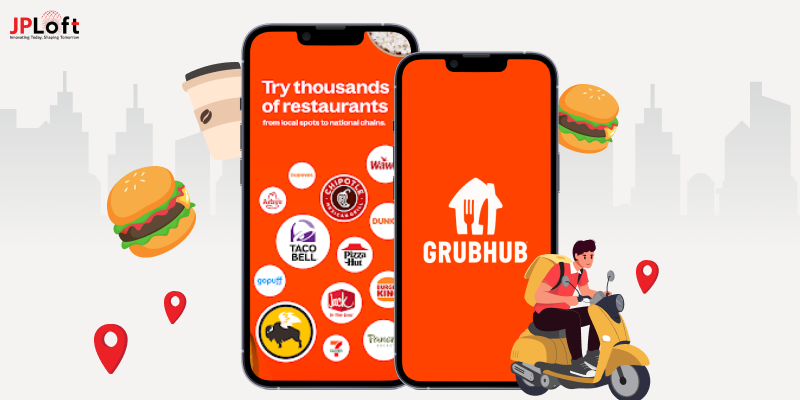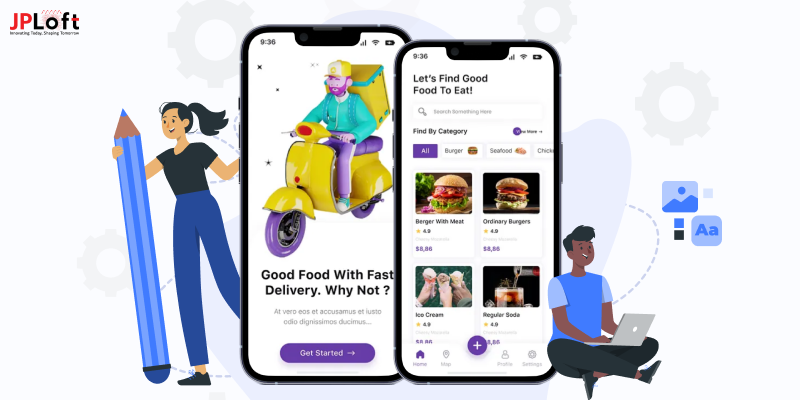Key Takeaways
The global online food delivery market is growing rapidly, projected to reach over USD 173 billion by 2025, and the right time to build an Uber Eats clone.
Steps to build an Uber Eats clone include defining the business model, market research, choosing a tech stack, designing, developing, and marketing.
Essential app features include user onboarding, restaurant listings, menus, real-time order tracking, and separate interfaces for different users.
AI enhances food delivery apps by enabling personalized recommendations, route optimization, smart chatbots, and demand forecasting.
Development costs of an app like Uber Eats range from USD 20,000 for a basic version to USD 250,000+ for a highly advanced, scalable app.
Monetization strategies include delivery fees, restaurant commissions, advertising, subscriptions, surge pricing, and additional small fees.
JPLoft specializes in developing high-performance, scalable, user-centric, and feature-rich apps like Uber Eats, tailored for your business needs.
In today’s fast-paced world, on-demand food delivery apps have become an integral part of modern lifestyles. Among them, Uber Eats has set a benchmark by revolutionizing the way people order, track, and enjoy their meals with just a few taps.
The success story of Uber Eats demonstrates the growing demand for convenience-driven digital solutions in the food industry.
For entrepreneurs and startups, knowing how to create an app like Uber Eats isn’t just about replicating its features. It's about creating a seamless, user-friendly, and scalable food delivery app that connects restaurants, delivery partners, and customers in real time.
To develop an app like Uber Eats, define your concept, design UI/UX, develop the front-end and back-end, integrate a payment system, use GPS for delivery tracking, build a reliable database, test the app, launch it, and ensure continuous updates.
In this blog, we will guide you through the essential steps, features, technologies, and strategies required to create a robust food delivery app like Uber Eats that can thrive in today’s competitive world.
All About Uber Eats: A Food Delivery App
Uber Eats is one of the leading global food delivery apps, launched in 2014 as an extension of Uber’s ride-hailing service. Operating in multiple countries, it connects millions of users with local restaurants, enabling them to browse menus, place orders, and get meals delivered quickly and conveniently.
The app integrates three key stakeholders: customers, delivery partners, and restaurants, ensuring a smooth digital marketplace where each participant benefits. Customers enjoy a wide variety of cuisines, restaurants expand their reach, and delivery partners gain flexible earning opportunities.
Uber Eats leverages advanced technology, such as real-time GPS tracking, AI-driven recommendations, and an intuitive interface, to create a seamless user experience. It also offers strategic partnerships, promotional campaigns, and subscription models, which provide free delivery and discounts, strengthening customer loyalty.
► Reasons for Uber Eats' Success
-
Brand Leverage: Built on Uber’s global reputation and user base.
-
Wide Restaurant Network: Partnerships with local eateries and global chains.
-
Technology-Driven: Real-time tracking, AI personalization, and secure payments.
-
Scalability: Quick expansion across multiple countries.
-
Customer-Centric Features: Easy-to-use app, offers, and subscription benefits.
-
Flexible Delivery Model: Independent drivers increase availability and reduce costs.
► Market Statistics and Growth
Now, let's take a look at the market statistics to better understand the grip strength of Uber Eats:
-
As estimated by Deliverect, the global online food delivery market is projected to reach USD 173.57 billion in value by the end of 2025, up from USD 156.75 billion in 2024.
-
In the United States, according to Deliverect, over 65% of people use food delivery services, making it the largest food delivery market worldwide.
-
It was found by BusinessOfApps that in 2024, the Uber Eats app generated around USD 13.7 billion in revenue, marking about a 13.2% year-over-year increase.
-
In research by BusinessOfApps, the total gross bookings of the food orders (before deductions) rose to USD 74.6 billion in 2024, with about 95 million users globally.
-
Uber Eats has partnered with one million restaurants or merchants around the world and is active in over 11,500 cities in more than 45+ countries worldwide, according to PYMNTS.
-
According to GlobalNewWires, in the United States alone, Uber Eats holds roughly 23% of the food delivery market share, trailing DoorDash.
With a clear grasp of what makes Uber Eats successful, the next step is to explore the compelling advantages to know how to develop an app like Uber Eats and create your own app in this thriving food delivery market.
Why Create an App Like Uber Eats?
Creating an app like Uber Eats offers a compelling business opportunity driven by booming demand for online food delivery, convenience, scalable revenue generation, and tech-fueled market disruption. Below are the reasons why building an app like Uber Eats can be a highly beneficial move for entrepreneurs:
1. Market Opportunity
The global food delivery industry is expected to reach USD 505.5 billion by 2030. Uber Eats itself holds a dominant market share in several regions, highlighting the scale and profit potential for new entrants. The idea to make an Uber Eats clone can become a high-ROI strategic move for entrepreneurs and startups.
2. Consumer Convenience
Busy lifestyles have increased the demand for food delivery apps, driving the growth of on-demand app development services. Features to develop an Uber Eats clone, like real-time tracking, seamless payments, and curated restaurant choices, have modernized the food ordering experience, increasing customer retention.
3. Revenue Growth and Monetization
Apps like Uber Eats operate on multiple revenue streams like platform commissions, delivery fees, ads, subscription perks, and premium listings, making them highly lucrative. Restaurants benefit from increased sales, while customers enjoy flexible food access, often driving loyalty and repeat business.
4. Scalability and Technological Advantages
Uber Eats employs a tech-driven marketplace model, easily scaling to new markets by leveraging networks of restaurants and delivery partners. The model supports innovative features such as scheduled deliveries, priority orders, and advanced data dashboards for performance tracking.
5. Competitive Differentiation
Modern food delivery apps like Uber Eats drive differentiation with curated experiences and unique features. If you make an Uber Eats clone with features like personalized search filters and extensive promotional tools, it benefits both user experience and initiates restaurant growth.
Create an app like Uber Eats, which enables entrepreneurs to capture part of a fast-growing industry, enhance customer convenience, access scalable business models, and leverage technology for competitive advantage.
Having understood the compelling reasons behind the advantage of knowing how to create an app like Uber Eats. Now it's essential to explore how such an app functions in practical life.
How Does an App like Uber Eats Work?
Uber Eats is a food delivery platform that connects customers with restaurants and delivery partners. It operates in several steps, from order placement to delivery. Here is a step-by-step process of how an app like Uber Eats works:
Step 1. User Registration and Login
-
Customers, restaurants, and delivery partners sign up on the app with their details.
-
Secure authentication ensures smooth onboarding.
Step 2. Browsing and Search
-
Customers explore nearby restaurants, cuisines, and dishes using filters, categories, and search.
-
AI-driven recommendations enhance personalization.
Step 3. Order Placement
-
Customers add meals to the cart, customize preferences, and confirm the order.
-
Multiple payment options (card, wallet, UPI, COD) ensure convenience.
Step 4. Order Confirmation and Delivery Partner Allocation
-
The restaurant receives the order request, prepares the meal, and updates the status in real time.
-
The app assigns the order to the nearest available delivery partner using GPS and route optimization.
Step 5. Real-Time Tracking and Notifications
-
Customers track the order status (confirmed, prepared, picked, en route) through push notifications and in-app updates.
-
Customers can contact the delivery partner for any inquiries regarding the food delivery.
Step 6. Order Pickup and Delivery
-
The delivery partner picks up the prepared meal from the restaurant.
-
The delivery partner delivers the food to the customer’s address within the estimated time.
Step 7. Payment Settlement
-
The platform deducts commission from the restaurant’s earnings and transfers the rest.
-
Delivery partners receive payouts based on completed orders.
Step 8. Ratings and Reviews
-
Customers can rate restaurants and delivery partners, helping maintain quality and trust.
-
Customers can also contact customer care for any type of assistance regarding the order.
Uber Eats has grown to be an essential service in many parts of the world by simplifying the food ordering process and providing reliable delivery. To follow up on how to build an app like Uber Eats, it’s essential to explore the key features that make such a platform efficient, user-friendly, and scalable, ensuring a seamless experience for all users involved.
Features to Include in an App like Uber Eats
When learning how to make an app like Uber Eats, you have to create a seamless, user-friendly experience for customers, restaurants, and delivery partners. However, here’s a list of essential food delivery app features to include in an app like Uber Eats:
|
Component |
Feature |
Description |
|
Customer App Features |
Easy Onboarding |
Quick sign-up/login via email, phone, or social accounts. |
|
Restaurant Listings & Search |
Browse by cuisine, location, price, or ratings. |
|
|
Smart Recommendations |
AI-based suggestions based on order history and preferences. |
|
|
Menu with Customization |
Add/remove ingredients, choose portion sizes, etc. |
|
|
Cart & Checkout |
Smooth ordering with multiple payment options (cards, wallets, COD). |
|
|
Real-Time Order Tracking |
Live GPS updates from preparation to delivery. |
|
|
Push Notifications |
Order status, offers, and delivery alerts. |
|
|
Ratings & Reviews |
Feedback on restaurants and delivery partners. |
|
|
Save Favorites |
Quick access to frequently ordered items. |
|
|
Subscription Plans |
Free delivery and discounts for loyal users. |
|
|
Restaurant App Features |
Restaurant Dashboard |
Manage orders, menus, pricing, and availability. |
|
Order Management System |
Accept, prepare, and update order status in real time. |
|
|
Menu Customization |
Add new items, images, or seasonal offers. |
|
|
Analytics & Insights |
Track sales, peak times, and customer preferences. |
|
|
Payout Management |
Secure settlements with commission breakdown. |
|
|
Delivery Partner App Features |
Easy Registration & Verification |
Quick onboarding with ID checks. |
|
Order Alerts |
Real-time notifications of new delivery requests. |
|
|
GPS Navigation |
Optimized routes for faster delivery. |
|
|
Earnings Tracker |
Daily/weekly income insights. |
|
|
Availability Toggle |
Go online/offline based on preference. |
|
|
Ratings & Reviews |
Performance feedback from customers. |
|
|
Admin Panel Features |
User Management |
Oversee customers, restaurants, and delivery partners. |
|
Order Monitoring |
Track and manage orders across the platform. |
|
|
Commission & Payment Management |
Automated settlements and reports. |
|
|
Promotions & Discounts |
Manage offers, coupons, and marketing campaigns. |
|
|
Advanced Analytics |
Business insights, growth tracking, and demand forecasting. |
|
|
Fraud & Dispute Management |
Ensure platform safety and reliability. |
Advanced Additional Features for Competitive Edge
-
In-app chat support: for customer and delivery partner communication.
-
Voice Search Integration: for easy browsing.
-
Multi-language & currency support: for global reach.
-
AI chatbots: for 24/7 customer support.
-
Order scheduling: to pre-book meals.
The features you include while you build an app like Uber Eats will depend on your specific target audience, business model, and services you intend to offer. You can add extra features depending on your specific market and brand positioning, but these core features will provide a solid foundation for any food platform.
Now it’s time to dive into the easy-to-follow steps to build an Uber Eats clone, guiding you throughout the development journey, from initial planning and design to deployment. Helping you avoid any type of food delivery app development challenges.
How to Build an App Like Uber Eats?
Building an app like Uber Eats requires careful planning, technical expertise, and a clear understanding of user needs. Below are the steps to develop a food delivery app like Uber Eats, from conceptualization to launch, to help you build a successful app:
Step 1. Define Your Business Model
Before you dive into your food delivery app development process, it's crucial to define the business model for your app. Having a clear vision for your business model will help build a custom app like Uber Eats. There are several key components to consider:
-
Target Audience: Are you focusing on local restaurants, fast food chains, or gourmet meals? Understanding your customer base is essential.
-
Monetization Strategy: Choose how you will generate revenue. Common strategies include charging commissions on restaurant orders, delivery fees, subscription models, and restaurant advertisements.
-
Geographical Focus: Will your app operate in a single city or multiple locations? Initially, start food delivery app business small and scale as your platform grows.
Step 2. Market Research and Analysis
Conduct thorough market research to understand your competition, customer behavior, and food delivery app trends. Focus on the following:
-
Competitor Analysis: Study existing apps developed like DoorDash and GrubHub. Identify what works well and areas where you can improve or offer unique value.
-
Customer Needs: Understand what your target users want, such as fast delivery, easy-to-navigate interfaces, and various payment options.
-
Local Market Dynamics: Analyze the food delivery landscape in your target city or region. Consider customer preferences, average delivery times, and the types of restaurants that are popular.
Step 3. Choose the Right Technology Stack
Selecting the appropriate mobile app tech stack is crucial for building a scalable, secure, and reliable food delivery app. Some common components include when you create an app like Uber Eats:
-
Frontend: Choose a platform for the user interface (UI), such as React Native for cross-platform development or Swift for iOS and Kotlin for Android.
-
Backend: Use technologies like Node.js, Ruby on Rails, or Python/Django to handle server-side logic, user management, and data storage.
-
Database: For scalable data storage, use MySQL, MongoDB, or PostgreSQL.
-
Geolocation & Mapping: Integrate Google Maps API or Mapbox for real-time tracking of deliveries and restaurant locations.
-
Payment Gateway: Incorporate payment solutions like Stripe or PayPal for secure online transactions.
-
Cloud Hosting: Use services like Amazon Web Services (AWS) or Google Cloud to ensure that your app can scale as your user base grows.
Step 4. Design the User Interface (UI) and User Experience (UX)
A smooth and intuitive food delivery app design is essential to retaining users. The UI/UX should be simple, visually appealing, and easy to navigate. Key design elements to focus on while following the steps on how to build an app like Uber Eats:
-
Customer App: Design an interface that allows users to easily browse restaurants, view menus, customize their orders, and track deliveries in real time.
-
Restaurant Dashboard: Provide an easy-to-use mobile app design for restaurants to manage their menus, track orders, and update availability.
-
Delivery Partner App: Create a simple interface for delivery drivers to view assigned deliveries, track routes, and manage earnings.
Step 5. Develop Core Features
Now, it's time to build the core features of your Uber Eats-like app. Here are the key functionalities to include when you create a food delivery app like Uber Eats:
A] For Customers:
-
Sign-up/Login
-
Restaurant Discovery
-
Order Customization
-
Payment Gateway
-
Order Tracking
-
Ratings & Reviews
B] For Restaurants:
-
Dashboard
-
Inventory Management
-
Order Notifications
C] For Delivery Partners:
-
Route Optimization
-
Earnings Tracking
-
Availability Settings
Step 6. Test the App
Testing is critical to ensuring the app works as intended. Focus on different types of mobile app testing:
-
Functional Testing: Check if all features, such as placing an order, processing payments, and tracking deliveries, work correctly.
-
Usability Testing: Ensure that the app is user-friendly and easy to navigate for all parties.
-
Performance Testing: Evaluate how well the app performs under different conditions, such as high traffic or peak order times.
-
Security Testing: Ensure that the app is secure, especially for payment and personal data handling.
Step 7. Launch and Marketing
Once you build a custom app like Uber Eats and it has been tested and polished, it's time for launch. You can follow these steps:
-
Soft Launch: Start with a small group of users in a limited geographic area to test the app’s performance and gather feedback.
-
Marketing Strategy: Use various channels like social media marketing, Google Ads, and SEO to create buzz about your app. Offer discounts and promotions to attract early users.
-
Referral Programs: Introduce referral bonuses for users who invite friends or family to use the app.
Step 8. Maintenance and Continuous Improvement
Another important step of how to develop an app like Uber Eats is the maintenance of the app after launch. To ensure long-term success, you must provide regular updates and maintenance, including:
-
Bug Fixes: Address any technical issues promptly.
-
New Features: Continuously improve the app by adding new features based on user feedback, such as AI-driven recommendations, loyalty programs, or multi-language support.
-
Scaling: As your user base grows, ensure the app can scale by optimizing server infrastructure and app performance.
-
Maintenance Services: Hiring an experienced mobile app maintenance service provider to get the best industry-level results
To develop an Uber Eats clone requires a well-thought-out strategy, the right technology stack, and a focus on user experience. By following these steps and hiring an expert mobile app development company in the UK, your delivery app will become a strong competitor in the market.
In the next section, we will explore how AI can be a game-changer while you build an app like Uber Eats, enhancing customer experience and operational efficiency with smart automation.
Can AI be useful to make an app like Uber Eats?
AI can play a significant role in enhancing an Uber Eats-like app, making it smarter, more efficient, and more personalized for both users and businesses. Here are some ways AI can help create a food delivery app like Uber Eats:
1] Personalized Recommendations
AI analyzes user preferences, order history, and behavioral data to suggest restaurants and dishes tailored to individual tastes, increasing user satisfaction and repeat business of the Uber Eats app development. This hyper-personalization also improves conversion rates and encourages longer user engagement on the app.
2] Route Optimization and Faster Deliveries
Machine learning models compute real-time traffic, driver availability, and restaurant prep times, enabling optimal delivery routing for fresher food and reduced wait times. This reduces delivery costs and enhances the overall operational efficiency of the platform.
3] Predictive Demand and Inventory Management
AI forecasts busy periods, trending dishes, and inventory needs, minimizing waste and ensuring popular items stay available for customers. Build an AI app with such features as this predictive insight helps restaurants optimize stock levels and prepare for demand spikes seamlessly.
4] Smart Chatbots and Order Assistance
AI-powered chatbots enhance customer engagement after you develop an app like Uber Eats by providing instant order tracking, meal suggestions, and automated support, reducing operational workload. They also improve response times and provide 24/7 support, elevating customer satisfaction.
5] Monetization and Targeted Advertising
AI facilitates smart subscription models, identifies profitable users, and powers personalized advertising, boosting customer engagement and platform revenue. The intelligent analysis of user behavior also supports dynamic pricing strategies to maximize profits while you create an app like Uber Eats.
6] Autonomous and Next-Gen Logistics
One of the top food delivery ideas is taking the help of AI to use autonomous drones and delivery robots for fast, efficient, automated service, already piloted in the industry by major brands. These technologies promise to overcome last-mile delivery challenges and reduce human resource dependency in the future.
Integration of AI helps an app become smarter, faster, and more user-friendly, while also reducing Uber Eats like app development costs and boosting efficiency. Partnering with an experienced AI app development company to deploy AI can help make a more seamless and efficient food delivery service.
After exploring how AI benefits the development, it's important to know the cost to build an app like Uber Eats, to have an estimation of the investment budget.
What's the cost to develop an app like Uber Eats?
To create an Uber Eats clone, the estimated total development cost ranges between USD 20,000 and USD 250,000+, based on the app complexity. Here is a detailed breakdown of the cost to build an app like Uber Eats to help you plan your development budget for an app like Uber Eats:
|
Component |
Featured Covered |
Estimated Cost (in USD) |
|
UI/UX Design |
Wireframes, user flows, interactive prototypes, and responsive design |
$5,000 – $15,000 |
|
Customer App Development |
Registration, browsing, ordering, payments, tracking, reviews, notifications |
$25,000 – $40,000 |
|
Restaurant App Development |
Menu management, order handling, analytics, payouts |
$15,000 – $25,000 |
|
Delivery Partner App |
Order alerts, navigation, earnings tracker, availability toggles |
$15,000 – $25,000 |
|
Admin Panel Development |
User management, analytics, order monitoring, commission setup, dispute management |
$20,000 – $30,000 |
|
Backend Development |
APIs, database architecture, cloud integration, authentication, security |
$25,000 – $40,000 |
|
Third-Party Integrations |
Payment gateways, GPS navigation, push notifications, SMS/email APIs |
$10,000 – $15,000 |
|
Testing & QA |
Mobile app security, functional, performance, and usability testing |
$8,000 – $12,000 |
|
Project Management |
Planning, coordination, sprint management, and delivery oversight |
$7,000 – $10,000 |
|
Maintenance (Per Yearly) |
Bug fixes, updates, server costs, new feature rollouts |
$10,000 – $20,000 |
App Complexity with Total Cost to Build a StyleSeat Clone:
► Basic MVP:
-
Features: Single platform or simpler UI/UX. Core features only with fewer integrations.
-
Development Time: 3 to 5 months
-
Estimated Cost in USD: $20,000 – $70,000
► Mid-Level App:
-
Features: Real-time tracking, map services, more polish, etc., and more features, better design, both iOS & Android platforms.
-
Development Time: 5 to 6 months
-
Estimated Cost in USD: $70,000 – $150,000
► Advanced App:
-
Features: High scalability, advanced features like ML, heavy customization, large user base, etc.
-
Development Time: 6 to 12 months+
-
Estimated Cost in USD: $150,000 – $250,000+
Uber Eats like app development costs depend completely on the type of features, platforms, design, complexity, team location, and many other factors.
Knowing the investment required to build an Uber Eats Clone is just the first step. To truly succeed, it’s essential to understand how to transform your app into a profitable business through effective monetization strategies.
How to Monetize an App Like Uber Eats?
Monetizing an app like Uber Eats involves several revenue streams that benefit both the platform and its users. Here is a list of some frequently used food delivery app monetization strategies by apps like Uber Eats:
1. Delivery Fees
Charge customers a delivery fee on each order, which can vary based on distance, location, and demand. This fee ensures compensation for drivers and covers logistics costs while maintaining affordable service options.
2. Commission Fees
Take a commission ranging from 15% to 40% on each order from partner restaurants. This model incentivizes restaurants to join the platform while creating a significant revenue stream for the app, especially with high order volume.
3. Marketing and Advertising Fees
Offer restaurants paid options to promote their listings through featured placements, sponsored ads, and special promotions within the app. This advertising boosts restaurant visibility and provides an additional income source for the platform.
4. Premium Subscriptions for Customers
Provide subscription services such as Uber One or Eats Pass that offer free deliveries, exclusive discounts, and priority access for a monthly fee. These subscriptions generate recurring revenue and enhance customer loyalty.
5. Surge Pricing During Peak Demand
Implement surge pricing during high-demand periods where delivery fees increase to motivate more drivers to be available, ensuring timely deliveries. This dynamic pricing boosts profits and service reliability during busy times.
6. Additional Charges
Add small order fees, service fees, or fees for deliveries in specific areas to cover operational costs and maintain profitability. These extra charges help balance costs without significantly impacting customer satisfaction.
The key to successfully monetizing an Uber Eats app development is to balance the interests of customers, restaurants, and delivery partners while offering value at every stage. Choosing multiple revenue streams is as important as understanding how to make an app like Uber Eats, as it ensures your platform can generate consistent income while growing in scale.
Build Your Dream App with JPLoft
Now, if you have made up your mind and are planning to take the next big step, to launch a powerful food delivery app like Uber Eats, JPLoft is your trusted technology partner.
With years of expertise to develop an app like Uber Eats, we specialize in building feature-rich, scalable, and user-friendly food delivery solutions that bring your business idea to life. Our team ensures every aspect, like the customer app, restaurant dashboard, delivery partner app, and admin panel, is crafted with precision, intuitive design, and robust technology.
At JPLoft, we don’t just deliver apps. We deliver complete business solutions. From seamless real-time tracking and secure payments to advanced analytics and AI-driven recommendations, we integrate everything you need to stand out in today’s competitive food delivery market.
Whether you’re a startup or an established business, our tailored development approach guarantees a faster go-to-market and long-term success. Partner with JPLoft, a dedicated food delivery app development company, today and transform your food delivery vision into a thriving digital platform.
Conclusion
The idea to create an Uber Eats clone is a rewarding opportunity in this fast-growing on-demand food delivery industry. Success depends on a well-researched strategy, the right technology stack, and a seamless experience for customers, restaurants, and delivery partners.
By focusing on intuitive design, reliable performance, and scalable infrastructure, you can deliver an app that meets user expectations with long-term growth. Also, integrating features such as AI-driven recommendations and subscription models will further strengthen your app’s position in the market.
Knowing how to develop an app like Uber Eats with constant improvements and customer satisfaction at the forefront, your platform can become a major player in the food delivery industry. Whether you are an entrepreneur or a business aiming to expand, investing in a high-quality food delivery solution ensures you stay competitive in this digital-first economy.
FAQs
To create an app like Uber Eats, start with market research and define your niche. Choose a sustainable business model, plan essential features, and select the right tech stack. Develop customer, restaurant, and delivery apps, test thoroughly, launch strategically, and continuously optimize for user experience and scalability.
The development cost ranges from USD 20,000 to USD 200,000+, depending on features, technology stack, and region of development. Choosing cross-platform solutions and outsourcing to cost-effective regions can help reduce expenses significantly.
On average, it takes 3 to 10+ months to develop, depending on complexity. An MVP version with core features can launch faster, while an advanced version with AI, analytics, and subscription models requires additional time.
Key features include real-time tracking, secure payments, personalized recommendations, restaurant dashboards, delivery partner tools, and an admin panel. Adding loyalty programs, chat support, and AI-driven suggestions enhances competitiveness.
Such apps earn through commissions from restaurants, delivery charges, advertising, and subscription models like Uber One. Additional revenue can come from partnerships, surge pricing, and value-added services like grocery or convenience store deliveries.












Share this blog